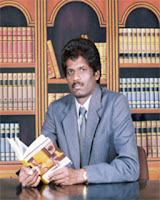When we joined with the German relief team in a few minutes, they were in a rather relaxed mood planning the day’s mission.
While I was walking in the back corridor of the church with the German university students, my memories went back to my meeting with then Bishop of Jaffna Dr. Thiyogupillai in my school days several years ago. His caring nature very much impressed me though I did not belong to the Catholic religious sector but had a faith in Jesus.

The Bishop of Jaffna Rt. Rev. Thomas Saundranayagam with German university students and Dietmar Doering, Founder/Director of the Asian-German Sports Exchange Program on a Tsunami Mission to Jaffna.
The Bishop of Jaffna Rt. Rev. Thomas Saundranayagam had a lengthy chat with all of us in the conference hall and praised the students for their kind service to the tsunami victims.
While I was returning in the corridors with the students, I was reminded of the era of Portuguese rule and how Catholism was introduced into Jaffna.
The conquest of Jaffna by the Portuguese under Captain General Constantine de Sa under the command of Philip de Oliveira in 1620-21 spelt the demise of the independent Kingdom of Jaffna. A pretext to capture Jaffna presented itself when the King of Jaffna, cruelly murdered about six hundred newly baptized Catholics in the Island of Mannar. Constantine de Braganza led an expedition and captured Mannar in 1560.
The main contribution of the Portuguese rule in Jaffna was the introduction of Roman Catholicism.
The Portuguese wantonly destroyed quite a number of Hindu temples and introduced many other measures against the Hindus. At one time historians say during the Portuguese rule in the 17th century, the Tamil-speaking Jaffna peninsula, a bastion of orthodox Shiva worshipping Hindus was entirely Catholic. Fernao de Queiros, the renowned Portuguese chronicler described Jaffna as being "wholly Christian".
The reasons for the en masse conversion of Jaffna Tamils were the unquestioned military and political power that the Portuguese exercised over the population of Jaffna, due to a variety factors one of which was that the Jaffna masses were non-aggressive, non-militarised and leaderless. Although St Francis Xavier had begun conversion in 1543 itself, it was only after the complete takeover of Jaffna that the conversions took place on a mass scale.
In order to increase the number of converts rapidly, they resorted to "general baptism".
A typical case of general baptism in a village was first the announcement of the arrival of the
Portuguese missionaries made by tom-tom. The villagers in question would be asked to assemble and then a missionary would ask them to reject their "false" gods and accept "one true God". It was not a request; it was almost a command backed by the authority of the Portuguese government. This is because the missionary would invariably be accompanied by the local Portuguese officials and the native chiefs who supported them. Fear of a fine or corporal punishment with cane and stock would ensure their regular attendance at church on Sundays and feast days.
An un-named writer is quoted as saying that the Hindus believed under force that there were different paths to salvation and that there was nothing wrong in accepting Catholicism.
The Portuguese rule ruined Jaffna and burdened the Jaffna peasant as he had to pay heavy taxes, which the Portuguese kept hiking from time to time. The cash from the Jaffna treasury was being used to fund Portuguese settlements elsewhere. Nothing was ploughed back into the local economy. According to Fernao de Queiros, the people of Jaffna had been "reduced to the utmost misery" under Portuguese rule.
In the absence of the possibility of waging war or revolting, the only option for the people was to migrate. They migrated to the Wanni jungles in the South of the peninsula and by crossing the Palk Strait to India.
The people of Jaffna were immensely relieved when the Dutch overthrew the Portuguese in June 1658.
The refugees not only came back to Jaffna, but shed Catholicism and reverted to Hinduism en masse. Some of course, took to the Protestant religion of the Dutch.
The converts who believed there were different paths to salvation, reverted back to Hinduism. Only the people from coastal areas of the Gulf of Mannar and some coastal areas in the Jaffna Peninsula saw Catholicism as a liberating path and stuck to it.
Though the Jaffna Peninsula today is a Hindu-dominated area in population, the Bishop of Jaffna is highly respected by all communities irrespective of their religious differences. And still the Church is playing a powerful, influential and healthy role in the life of the Tamils in the Peninsula.













